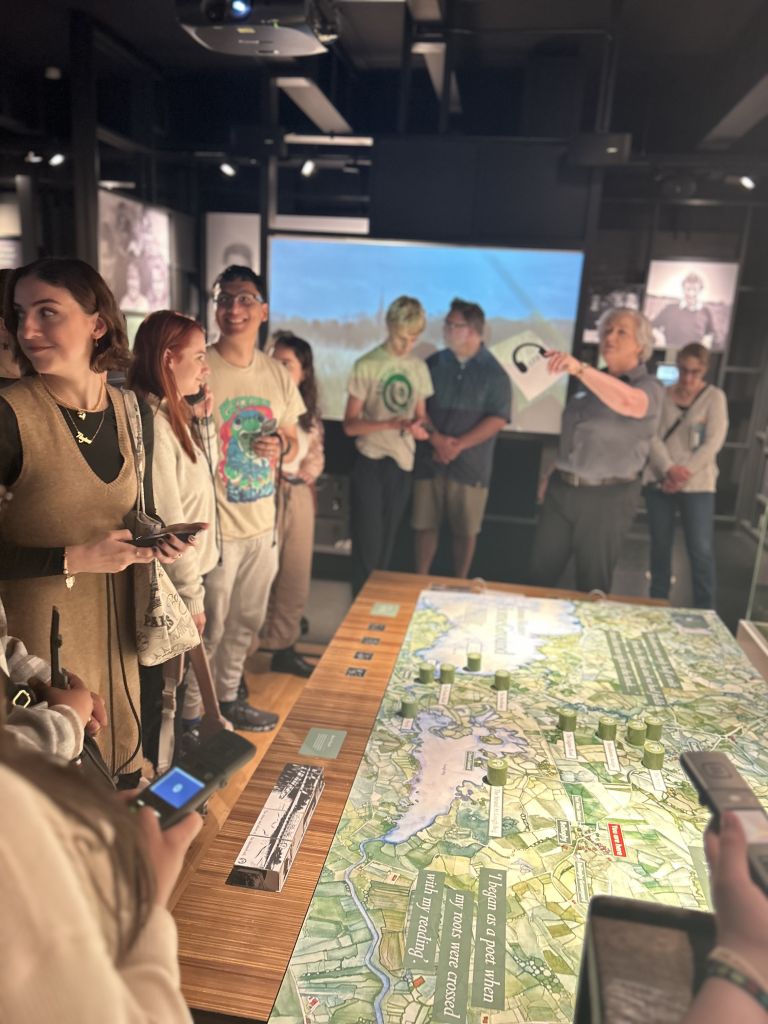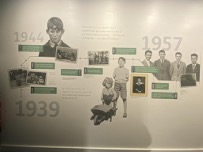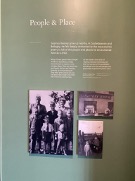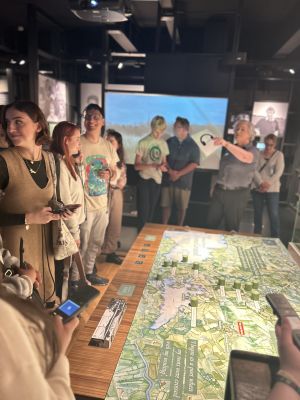“Between my finger and my thumb / The squat pen rests. / I’ll dig with it.” –Seamus Heaney, “
The quote cited at the top of the page comes from one of the most famous poems by one of the most influential Northern Irish poets, Seamus Heaney. On Wednesday, May 29, we visited the museum dedicated to Heaney, and read–and heard–this poem as well as many, many others.
The Seamus Heaney HomePlace museum in Bellaghy takes you on a tour of Heaney’s life through his poetry. The exhibition begins in the basement, with an exhibit entitled “People and Place” that is dedicated to showcasing the way that Heaney’s childhood, relationships, and hometown area inspired much of his work.
The exhibit included a timeline of Heaney’s life, brief explanations of his important relationships and the poems written to those people, and a large map that pinpointed the different places in Northern Ireland directly represented in his poetry.

From left: Gracie, Kiara, Rolando, Lindsey, Thomas, Kyle, Mary (our tour guide), Jessica. Photo by Adriana Guevara
One of the coolest aspects of this museum was the handheld listening devices provided. Each poem displayed around the museum had a corresponding three-digit number that could be typed onto the listening device. Once the play button was pressed, you were able to hear a recording of Seamus Heaney himself reading the poem. Heaney’s expressive and sincere speaking voice gave life and feeling to the poems and allowed the exploration of the museum to become a deeper and more profound experience.
However, the experience didn’t end at the poems. At the top of the stairs, many small white placards hang from strings tethered to the ceiling. These placards contain a variety of unique and weird words used in Heaney’s poetry, ranging from “thrawn” to “lea” to “croagh.”
My personal favorite was “dinnsheanchas” (pronunciation unknown, to me at least). Dinnsheanchas is a genre of Irish literature that recounts stories associated with place names. Immediately upon reading this definition, I was reminded of a play we read in my World Literature class a year ago entitled “Translations” by Brian Friel. This play emphasized the importance of place names in Ireland because of their connection to the Irish language, which is greatly endangered, largely as a result of British colonization. In fact, during the early stages of British rule, many place names in Ireland, originally in Irish, were anglicized to make them “easier” to pronounce and understand. With that history in mind, dinnsheanchas becomes even more important, and Heaney’s contributions to poetry more poignant.
The museum contained even more places of interest, such as a beautiful library and a picturesque garden, and we all wished we could have had more time to explore. Even though not all of us got to experience every part of the museum, we were all able to analyze one of Heaney’s poems with a museum employee. We gained some important knowledge about the history of conflict in Northern Ireland and, through Heaney’s words, got to understand, just a little, what it may have been like to live through those events firsthand.
We all experienced many different thoughts and emotions while visiting this place. Even your two blog authors had vastly different takeaways from our time there.
–Lindsey Graber
Personally, going to the Heaney Museum was more than just a pleasant visit: it also felt like honoring Heaney for my mom. My mom got to see Heaney live at her university in the eighties and greatly enjoyed his poems. Heaney was such an influential poet that over 800 university students came to Heaney’s reading of his poetry.
I think what makes Heaney’s poems so moving is that his poems are about specific people in his life, like his mother, grandfather, wife, and children, just to name a few. Heaney doesn’t just tell his readers about the people in their lives, what they look like, and how they affected his life, but he also makes the people in his poem relatable. For example, in Heaney’s poem “Casualty,” he honors a man he knew who most likely didn’t receive a college degree, was a breadwinner, and had much more conservative ideals and beliefs than I do. I can personally think of someone in my life who fits that description, and after talking with other peers, they can think of someone in their lives who fits the description as well.
Heaney also writes about events in his life, specifically about the Northern Ireland Conflict 1969-1998. The Conflict was political violence within Northern Ireland between Protestants who wanted to remain part of the United Kingdom and Catholics who wanted Ireland to become its own independent Republic. In “Casualty,” Heaney writes not only about the person he knew who died, but also about a march that took place on January 30th, 1972, known as Bloody Sunday, where 14 marchers were killed by the British Army Paratroopers in Derry/Londonderry. Heaney makes it possible for his readers to visualize the event he is writing about by giving clear descriptions of the environment, the sounds, and the people affected. (We are looking forward to visiting the Bloody Sunday memorial on Wednesday, June 5, and learning more about Derry/Londonderry, and how the people who lived there experienced the Troubles.)
The Seamus Heaney HomePlace museum goes beyond just having the poems displayed; however, as mentioned before, visitors can listen to Heaney reading his poems through their handheld devices, see some of his original works, see specific Irish words that have been used in his writing (like my favorite, “piggyback”), and examine the beautiful pictures of him and his family. The Museum brings another layer of who Heaney is and makes it possible for many people to view and appreciate his, what I call, art.
–Madeleine Kelly-Kellogg













